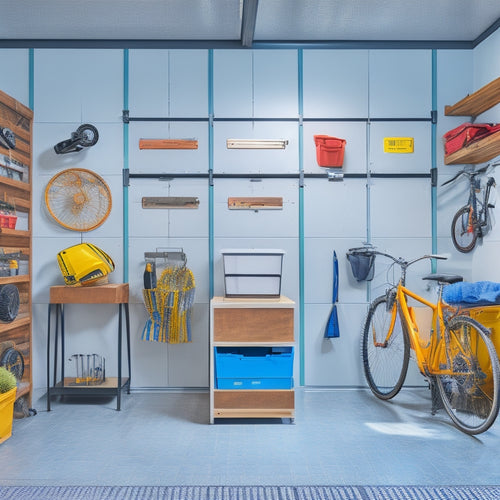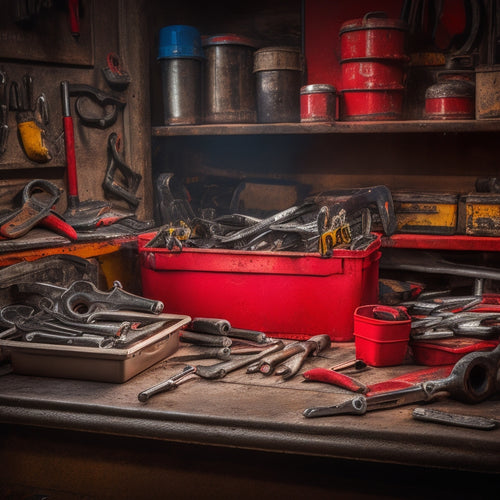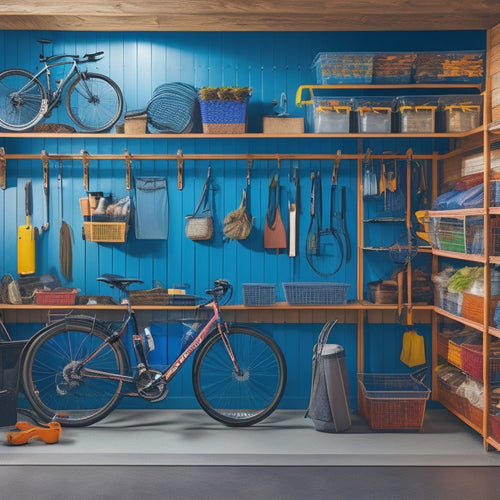Garage Tool Boxes for a Clutter-Free Workspace
Share
You've invested a significant amount of time and money in your garage tools, and it's time to keep them organized and within easy reach with a garage tool box that effectively maximizes your workspace. By choosing the right tool box, you'll enjoy benefits like reduced clutter, improved accessibility, and increased time efficiency. Consider key features like size, durability, and organizational design to find the perfect fit for your garage. With the right tool box, you'll be able to customize your space, prioritize frequently used tools, and minimize tripping hazards - and that's just the start of creating a clutter-free haven.
Key Takeaways
- Organized tool storage reduces workspace clutter, improves tool accessibility, and increases time efficiency, allowing for a more productive workspace.
- Assessing tool types, usage frequency, and available space helps determine the right toolbox size and style for a clutter-free garage.
- Durable construction materials, such as steel or aluminum, ensure safe storage for tools, while weather-resistant coatings protect against environmental conditions.
- Customizable compartments, adjustable dividers, and hanging options enable efficient organization, maximizing toolbox space and streamlining workflow.
- Regular tidying, labeling, and deep cleaning schedules maintain a clutter-free garage, reducing the risk of accidents and tool damage.
Benefits of Organized Tool Storage
Your workspace's cluttered chaos disappears when you invest in organized tool storage.
With a well-structured storage system, you'll no longer waste time searching for misplaced tools or risk injury from tripping over scattered equipment. Instead, you'll enjoy the benefits of improved tool accessibility, which means you can quickly find the right tool for the job. This, in turn, enhances your time efficiency, allowing you to complete tasks faster and more accurately.
A clutter-free workspace also reduces the risk of accidents, as you're less likely to knock over tools or trip over cords. Additionally, organized tool storage helps prevent damage to your equipment, keeping them in good condition and extending their lifespan.
Types of Garage Tool Boxes
Several types of garage tool boxes cater to different needs, preferences, and budgets, offering a range of features and functionalities to suit your specific requirements.
You can choose from portable toolboxes that allow you to carry your tools to different workstations or job sites, making them ideal for professionals or DIYers who work on multiple projects. These portable units often come with handles, wheels, or detachable compartments for added convenience.
For a more permanent setup, you can opt for stationary tool boxes that provide ample storage space for your tools and equipment. These can be mounted on walls or placed on the floor, keeping your tools organized and within easy reach.
If you have limited floor space, consider stackable storage solutions that allow you to maximize your vertical storage capacity. These units can be customized to fit your specific needs, with removable trays and adjustable compartments to accommodate tools of varying sizes.
Choosing the Right Tool Box
Selecting the right tool box is an essential step in optimizing your garage's organizational system and workflow. You need a tool box that meets your specific needs, guaranteeing you can efficiently access and store your tools.
When choosing a tool box, consider the following:
-
Tool selection tips: Think about the types of tools you'll be storing and the frequency of use. This will help you determine the ideal size and style of your tool box.
-
Toolbox styles: Consider the style of tool box that best fits your needs, such as a portable chest, roller cabinet, or wall-mounted unit.
-
Space constraints: Measure your available space to verify the tool box fits comfortably, allowing for easy access and movement around the garage.
-
Security: If you have precious or sensitive tools, consider a tool box with locking mechanisms to prevent unauthorized access.
-
Mobility: If you need to move your tool box around the garage or to different work sites, look for one with wheels or a handle for easy transport.
Key Features to Consider
When selecting a garage tool box, you'll want to evaluate several key features that'll make a big difference in your workspace.
You'll need to reflect on the size of the toolbox and whether it'll fit comfortably in your garage, as well as the durability of the construction materials to guarantee it can withstand heavy use.
Additionally, you should look for a toolbox with an organizational compartment design that'll help you keep your tools tidy and within easy reach.
Toolbox Size Options
You'll want to contemplate your garage's available space and the types of tools you need to store when choosing a toolbox size. This consideration will help you find a toolbox that fits comfortably in your garage while still holding all your essential tools.
When selecting a toolbox size, consider the following:
-
Portable toolboxes with compact designs that can be easily moved around the garage or taken to job sites are ideal for small to medium-sized tool collections.
-
Larger toolboxes with more storage capacity are suitable for extensive tool collections or for those who need to store bulky equipment.
-
Measure your garage space to guarantee the toolbox fits comfortably, leaving enough room to move around it.
-
Consider the height and width of the toolbox to guarantee it fits under shelves or in corners.
-
Think about the frequency of use and accessibility needs, as some toolboxes may be more convenient to access than others.
Durable Construction Materials
A toolbox's durability hinges on its construction materials, which can make or break its performance in a busy garage.
You'll want to prioritize materials that can withstand the rigors of daily use and harsh environmental conditions. When it comes to durable construction materials, you're likely to encounter two main options: steel and aluminum.
Steel toolboxes offer superior strength and durability, making them ideal for heavy-duty applications. However, they can be prone to rust and corrosion if not properly coated or protected.
Aluminum toolboxes, on the other hand, are lightweight, corrosion-resistant, and often more affordable. However, they may not be as sturdy as their steel counterparts.
Regardless of the material you choose, look for weather-resistant coatings or treatments to guarantee your toolbox can withstand exposure to moisture, heat, and cold.
A well-constructed toolbox with weather-resistant materials will provide a safe and reliable storage solution for your important tools and equipment.
Organizational Compartment Design
Two essential aspects of a garage tool box's design are its compartmentalization and organization, which greatly impact the accessibility and visibility of your tools.
A well-designed compartmental system guarantees that each tool has its dedicated space, making it easy to find what you need when you need it.
When evaluating a garage tool box's organizational compartment design, consider the following key features:
- Adjustable dividers that allow you to customize the compartment functionality to fit your specific toolset
- A mix of small and large compartments to accommodate various tool sizes
- A pegboard or hooks for hanging frequently used tools, freeing up space inside the box
- A tray or drawer for storing small items like nuts, bolts, and screws
- A lid or door that stays open at a 90-degree angle, providing easy access to the contents without obstructing your workspace
Maximizing Tool Box Space
Maximizing tool box space is vital for efficient storage and quick access to your tools. You can achieve this by implementing effective tool organization and storage solutions. Start by categorizing your tools into groups, such as hand tools, power tools, and accessories.
Then, assign a designated space for each group within your tool box. This will help you to quickly locate the tool you need, saving you time and reducing frustration.
Consider using dividers, bins, and trays to separate and store small items like screws, nuts, and bolts. Label each compartment to guarantee easy identification.
You can also use adjustable shelves and hooks to store larger items like hammers, drills, and wrenches. By optimizing your tool box space, you'll be able to fit more tools in a smaller area, reducing clutter and making your workspace safer.
With a well-organized tool box, you'll be more productive and efficient, allowing you to focus on your projects rather than searching for misplaced tools.
Customizing Your Tool Box
You can tailor your tool box to fit your specific needs by designing a customized layout that streamlines your workflow.
By creating personalized compartments, you can guarantee that frequently used tools are easily accessible and less commonly used items are stored out of the way.
With a well-planned layout, you'll be able to quickly find what you need, saving you time and frustration in the long run.
Tool Box Layout
While designing your ideal garage tool box, the layout plays a crucial role in determining its functionality and efficiency. A well-planned layout guarantees that your tools are easily accessible and visible, making your work more efficient and safe.
To achieve the best tool accessibility and visibility, consider the following:
-
Place frequently used tools in easy-to-reach locations, such as the top tray or front compartments, to reduce straining and bending.
-
Organize tools by category, like wrenches, pliers, and screwdrivers, to facilitate quick identification and retrieval.
-
Designate specific areas for larger equipment, such as power tools and compressors, to prevent clutter and tripping hazards.
-
Install dividers or separators to keep similar tools, like sockets and ratchets, from getting mixed up or lost.
-
Leave sufficient space between tools and compartments to prevent overcrowding and allow for easy cleaning.
Personalized Compartments
With a well-planned layout in place, the next step in designing your ideal garage tool box is to create personalized compartments that cater to your specific needs and tool collection. This is where you get to customize your tool box to fit your unique requirements, ensuring that every tool has its designated spot and is easily accessible.
You can achieve this by installing custom dividers that separate your tools into distinct categories, such as hand tools, power tools, and automotive tools. These dividers will prevent tools from getting jumbled together, reducing the risk of damage and making it easier to find what you need quickly.
Additionally, consider incorporating adjustable shelves that can be customized to fit tools of varying sizes. This will enable you to maximize your storage space and keep your tool box organized and clutter-free.
Maintaining a Clutter-Free Garage
Organizing a garage space can be a challenging task, especially when clutter has built up over time. However, with a well-planned garage tool box system, you'll be well on your way to maintaining a clutter-free garage.
To guarantee workspace efficiency, it's crucial to establish habits that promote garage organization.
Here are some tips to help you maintain a clutter-free garage:
-
Set aside time each week to tidy up your workspace, putting away tools and supplies in their designated compartments.
-
Implement a "one in, one out" policy to prevent clutter from building up again.
-
Label each compartment and shelf so you can easily find what you need.
-
Store hazardous materials, such as chemicals and fuels, in well-ventilated areas away from heat sources.
-
Consider implementing a regular deep cleaning schedule to tackle tougher messes and grime.
Frequently Asked Questions
Can I Install a Tool Box on a Concrete Garage Floor?
You can install a tool box on a concrete garage floor, but first, you'll need to prepare the floor by cleaning and degreasing it, then applying a non-slip coating to guarantee a secure tool box installation.
How Often Should I Clean My Tool Box to Prevent Rust?
You think you're too busy to clean your tool box? Think again! Regular tool maintenance is essential for rust prevention. Clean your tools and box every 2-3 months to keep them rust-free and extend their lifespan.
Are Garage Tool Boxes Suitable for Outdoor Use?
When considering outdoor storage, you'll want to guarantee your tool box is built for outdoor durability, featuring weather-resistant materials and coatings to protect your tools from the elements, so you can store them safely outside.
Can I Add Casters to a Stationary Tool Box?
As you ponder toolbox modifications, you're in luck! You can indeed add casters to a stationary tool box, releasing mobility options that'll make your workspace more efficient and safer, allowing you to easily move heavy tools around.
Are Tool Boxes Waterproof or Water-Resistant?
You'll find that many tool boxes are built with waterproof materials, but it's essential you perform regular tool box maintenance to guarantee their water-resistance lasts, as moisture can seep in through seals and hinges over time if not properly inspected and cleaned.
Conclusion
As you stand in your newly organized garage, surrounded by neatly stored tools and a sense of accomplishment, it's no coincidence that you feel more focused and productive. A clutter-free workspace isn't just about aesthetics; it's about working smarter, not harder. By investing in a garage tool box and customizing it to your needs, you've taken the first step towards a more efficient you. Now, get back to work and enjoy the fruits of your labor!
Related Posts
-

3 Pro Garage Organization Ideas to Try Now
You can alter your garage from cluttered chaos to organized oasis with three pro garage organization ideas. First, op...
-

Top Wrench Tool Box Sets for Every Mechanic
You're looking for high-quality wrench tool box sets that cater to your specific needs as a mechanic. From top-rated ...
-

Garage Wall Storage Ideas to Boost Productivity
You can enhance your garage's productivity by capitalizing on your ceiling height with overhead racks, storing bulky ...


